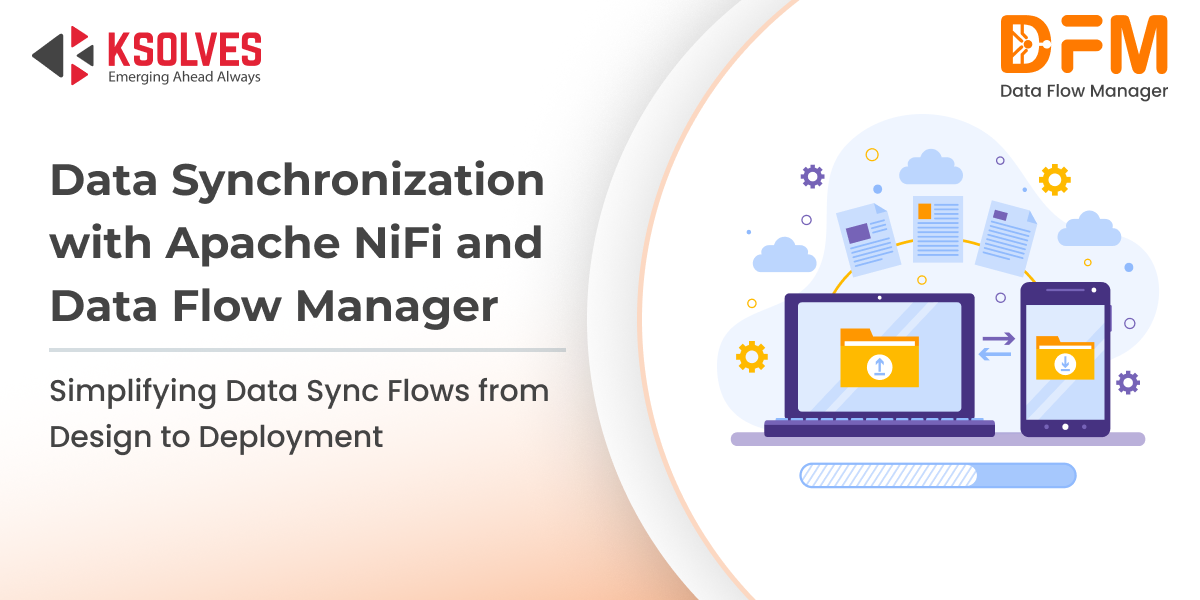Using Apache NiFi for Efficient Data Synchronization Across Systems
![]()

Modern enterprises run on a symphony of systems, such as ERPs, CRMs, analytics engines, cloud services, data lakes, and more. Each of these platforms generates and consumes data, and for the enterprise to function smoothly, that data must move seamlessly and intelligently between systems. This orchestration, known as data synchronization, is critical, yet incredibly complex.
Apache NiFi is a visual data ingestion and integration tool that also serves as a flow orchestration tool to handle this complexity with elegance. Whether it’s syncing inventory from SAP to Salesforce, moving IoT readings from edge devices to the cloud, or harmonizing customer records across databases, NiFi provides a flexible, scalable solution.
In this blog, we’ll explore how Apache NiFi can be used to achieve efficient, real-time, and secure data synchronization across diverse systems, ensuring data integrity, reducing manual effort, and enabling faster decision-making.
Understanding Apache NiFi as The Digital Logistics Manager
Apache NiFi is more than just an ETL tool. It is a data logistics platform that uses flow-based programming to automate the movement and transformation of data. Designed initially by the NSA and later open-sourced under the Apache Foundation, NiFi excels at making data pipelines intuitive, traceable, and adaptive.
What sets NiFi apart is its drag-and-drop canvas, where users build complex workflows visually, without diving into endless lines of code. Every flow file (i.e., unit of data) is tracked, secured, and processed in accordance with user-defined logic.
Unique Capabilities of Apache NiFi for Data Synchronization:
- Data Provenance: Every piece of data can be traced from its origin to its destination with a full audit trail.
- Fine-Grained Flow Control: From backpressure to prioritization, users can shape traffic like a network router.
- Built-in Fault Tolerance: If a destination system fails, NiFi holds data in queues and retries without loss.
- Integrated Security: NiFi supports end-to-end encryption, fine-grained role permissions, and data anonymization.
It’s not just a bridge – it’s a smart, policy-driven traffic controller for your enterprise data.
The Real Challenges of Synchronizing Data Across Systems
At a glance, data synchronization seems straightforward – get System A and System B to share the same data. But in real-world enterprise environments, this simple idea quickly unravels into a complex web of technical challenges, evolving requirements, and inconsistent data behaviors. Let’s unpack the intricacies that make synchronization not just difficult, but mission-critical.
1. Incompatible Data Formats
Each system speaks its own language. One might produce data in XML, another expects JSON. Some systems might send nested objects, others flat key-value pairs. In some cases, legacy systems output binary data without a schema, making interpretation a guessing game. Without a mediator capable of on-the-fly translation and format normalization, these differences act as barriers to seamless synchronization.
2. Varying Update Frequencies
Systems often operate at dramatically different tempos. A CRM might log changes every few seconds, while an ERP syncs once nightly. Some platforms generate high-frequency sensor data; others rely on manual batch updates. These mismatched update cadences lead to inconsistencies unless managed by a system that understands time sensitivity and can orchestrate syncs dynamically.
3. Connectivity and Latency
Synchronization across on-premise and cloud platforms introduces variable latency, intermittent outages, and bandwidth constraints. APIs might time out, firewalls may block requests, or endpoints can become temporarily unreachable. Without intelligent buffering, retry logic, or failover handling, such issues can break entire sync pipelines and cause data loss or duplication.
4. Data Drift
Over time, systems evolve. New fields are added, others deprecated. APIs change. Validation rules tighten. What worked last month may suddenly fail today. This slow and often silent evolution, known as data drift, can disrupt synchronization, introduce errors, and create invisible misalignments between systems unless actively detected and adapted to.
5. Manual Intervention and Legacy Dependencies
In many organizations, sync jobs still rely on cron scripts, batch files, or manual triggers maintained by IT teams. These are fragile, poorly documented, and difficult to scale. Human errors, such as missed schedules, forgotten credentials, and outdated mappings, can result in costly delays and inconsistent data states.
How Apache NiFi Solves Synchronization with Intelligence
Apache NiFi offers a powerful, policy-driven, and visual solution to address each of the above challenges head-on. It doesn’t just move data – it understands the context, handles exceptions gracefully, and automates decision-making across the pipeline. Let’s look at how it transforms synchronization into a smooth, scalable operation.
1. Universal Connectivity
NiFi includes a vast library of pre-built processors that can read from and write to virtually any source or destination. Whether it’s a relational database, REST API, FTP server, cloud bucket, message queue, or even a sensor stream, NiFi supports it natively.
- Pull data from Salesforce, MySQL, MongoDB, Kafka, HDFS, Amazon S3, and more.
- Push data to multiple systems simultaneously without writing glue code.
- Easily connect disparate platforms using a visual, drag-and-drop interface.
This plug-and-play capability eliminates the need for point-to-point integrations and fosters true interoperability across systems.
2. Real-Time and Batch Operations
NiFi supports both real-time streaming and scheduled batch operations, allowing organizations to tailor data movement to the needs of each system.
- Use triggers like event listeners or pollers for instant synchronization when new data arrives.
- Combine both models in a hybrid flow (e.g., real-time for critical updates, batch for historical syncs).
This dual-mode capability ensures that synchronization is not only timely but also resource-efficient.
3. Transformation on the Fly
Data rarely fits perfectly from one system to another. NiFi offers a wide range of data transformation processors that enable in-stream processing with zero code.
- Use JoltTransformJSON, UpdateRecord, or ScriptedTransform to:
-
- Convert XML to JSON, or vice versa.
- Reformat date and currency fields to match destination requirements.
- Merge nested structures or split arrays into multiple records.
- Anonymize or mask sensitive fields, such as customer names or credit card data.
This makes NiFi a self-contained ETL layer, capable of standardizing, enriching, and cleaning data on the move.
4. Smart Error Handling
Real-world syncs rarely go perfectly. NiFi anticipates this by offering built-in error routing and intelligent retries.
-
- If a system goes down, NiFi automatically queues the data and retries with exponential backoff.
- Failed records can be routed to a failure path, stored in a dead-letter queue, or trigger alerts via email, Slack, or webhooks.
- Use processors like RouteOnAttribute to dynamically branch based on error codes, field values, or custom logic.
With NiFi, errors become part of the flow, not blockers to it, enabling resilient, self-healing pipelines.
5. Scalable by Design
NiFi is built for horizontal scalability, allowing it to grow with your data volumes and business complexity.
- Start on a single-node instance for simple flows.
- Scale to a cluster of NiFi nodes to handle millions of records in parallel.
- Distribute load across nodes and manage data locality for optimal performance.
- Handle spikes in traffic without crashing or data loss, thanks to NiFi’s backpressure and queueing mechanisms.
This architecture ensures NiFi remains performant and reliable, whether you’re syncing 10 records a minute or 10 million an hour.
Real-World Use Cases You Can Relate To
Apache NiFi isn’t just a powerful data tool – it’s solving real business problems across industries. Here’s how companies are using it in everyday scenarios:
1. Retail: Real-Time Inventory and Pricing Sync
A national grocery chain relies on NiFi to keep its e-commerce platform perfectly in sync with its warehouse ERP systems. As product availability and pricing data changes, NiFi ensures that updates are reflected online in near real-time. The result?
- Fewer out-of-stock surprises for customers
- Accurate pricing during flash sales
- Smarter promotion targeting, driven by up-to-date inventory data
2. Finance: Seamless Transaction Reconciliation
A global financial institution uses NiFi to reconcile daily transactions between its core banking systems and third-party regulatory reporting platforms. By automating the data flow and ensuring schema alignment, NiFi helps the bank:
- Maintain data consistency across systems
- Reduce the need for manual reconciliation
- Ensure compliance with strict regulatory standards
Also read: Minimizing Financial Losses by Accelerating Fraud Detection with Data Flow Manager
3. Manufacturing: Predictive Maintenance with IoT Data
On high-speed assembly lines, IoT sensors continuously stream temperature, vibration, and performance data. NiFi captures this stream, filters out irrelevant noise, and sends key metrics to an analytics engine. The outcome?
- Early detection of equipment issues
- Reduced downtime through proactive maintenance
- Better visibility into production efficiency
Also read: How Data Flow Manager Helped a Cable Service Provider Streamline IoT Data Pipelines
4. Tech Startups: Unified Customer Data Across Platforms
Fast-moving SaaS startups leverage NiFi to sync user profiles across tools like HubSpot (marketing), Salesforce (CRM), and Stripe (billing). With NiFi orchestrating data flows between these systems, teams get:
- A 360° view of customer activity
- More personalized marketing campaigns
- Smoother onboarding and billing experiences
How Data Flow Manager (DFM) Enhances NiFi’s Data Synchronization
Designing data flows in Apache NiFi for synchronization tasks is just the beginning. The real challenge arises when it’s time to deploy those flows to the production environment.
Traditionally, this involves the use of the NiFi UI, logging into separate NiFi instances (Dev, Stag, and Prod), manual export/import flows, and creating and configuring controller services – all of which are time-consuming and error-prone.
Such delays can disrupt time-sensitive data synchronization efforts, especially when rapid deployment is crucial for maintaining consistency across systems.
Data Flow Manager (DFM) solves this challenge by eliminating the need for using NiFi UI and controller services. It lets you deploy and promote NiFi flows in minutes. You no longer need to switch between separate NiFi instances like Dev, Staging, or Prod. DFM simplifies the process by allowing you to access and manage all environments from a single interface.
During flow deployment, it displays all required controller services for a selected flow, enabling you to edit, configure, or even add new ones on the spot.
This streamlined approach ensures faster, more reliable deployments without the complexity of traditional NiFi management. Now, your data synchronization pipelines can move to production faster, safer, and without manual overhead.
Key Features of DFM
Deploying and managing NiFi data flows becomes effortless with Data Flow Manager. Below are some of the standout features that make it an essential companion for seamless data synchronization across environments:
1. Effortless NiFi Data Flow Deployment
Forget about manual exports, XML configurations, or NiFi CLI commands. Data Flow Manager lets you deploy and promote complex NiFi data flows in minutes. Whether you’re moving NiFi data flows from development to production or tweaking an existing one, everything happens through a user-friendly interface.
2. Scheduled Flow Deployments for Better Control
Timing matters, especially when deploying data synchronization workflows. Data Flow Manager allows you to schedule those NiFi data flows for deployments, ensuring that updates roll out during non-peak hours or aligned with business cycles. No more midnight logins or risky manual rollouts.
3. Built-In Version Control with Easy Rollback
Worried about breaking a working NiFi data flow? With built-in versioning, every change is tracked. You can compare NiFi data flow versions, see what changed, and roll back instantly if something doesn’t go as planned. This provides peace of mind and promotes experimentation without risk.
4. Comprehensive Audit Logs
Transparency and accountability are built in. Data Flow Manager maintains detailed audit logs of every NiFi data flow deployment, capturing who deployed which flow, when it happened, and what changed. Ideal for compliance-heavy environments and operational governance.
5. Role-Based Access Control (RBAC)
Not every team member needs full control over production flows. With robust RBAC, you can define precise permissions, ensuring only the right people can deploy, edit, or approve data flow changes. This minimizes risk while promoting collaboration.
6. NiFi Flow Creation with AI
Speed up development with AI-assisted NiFi flow creation. Simply enter the source, destination, and description in natural language, and the AI assistant will create NiFi flows in no time.
7. Flow Performance & Structure Analysis
Understand how your NiFi flows perform and how they’re structured at a glance. Data Flow Manager provides detailed insights into flow metrics, bottlenecks, and inefficiencies.
Conclusion
Synchronizing data across disparate systems is no longer just a backend chore, it’s mission-critical for delivering real-time insights, consistent customer experiences, and operational efficiency. Apache NiFi rises to this challenge by turning chaotic data exchanges into elegant, automated flows that scale with your business needs. It brings intelligence to the heart of integration, making your data pipelines both powerful and adaptable.
However, building NiFi data flows is only half the story; getting them into production swiftly is where many teams stumble. That’s where Data Flow Manager steps in, turning NiFi data flow deployment and promotion from a long-hour task to minutes. Together, NiFi and DFM form a modern data backbone, quietly powering the apps, dashboards, and decisions that move your business forward.
![]()

